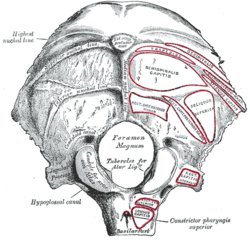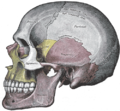- Occipital condyle
-
Occipital condyle 
Occipital bone. Outer surface. (Condyle for artic. with atlas labeled at lower left.) Latin condylus occipitalis Gray's subject #31 131 The occipital condyles are undersurface facets of the occipital bone in vertebrates, which function in articulation with the superior facets of the atlas vertebra.
The condyles are oval or reniform (kidney-shaped) in shape, and their anterior extremities, directed forward and medialward, are closer together than their posterior, and encroach on the basilar portion of the bone; the posterior extremities extend back to the level of the middle of the foramen magnum.
The articular surfaces of the condyles are convex from before backward and from side to side, and look downward and lateralward.
To their margins are attached the capsules of the atlantoöccipital articulations, and on the medial side of each is a rough impression or tubercle for the alar ligament.
At the base of either condyle the bone is tunnelled by a short canal, the hypoglossal canal.
Additional images
External links
- lesson9 at The Anatomy Lesson by Wesley Norman (Georgetown University)
- Roche Lexicon - illustrated navigator, at Elsevier 34256.000-2
- Roche Lexicon - illustrated navigator, at Elsevier 34257.000-1
This article was originally based on an entry from a public domain edition of Gray's Anatomy. As such, some of the information contained within it may be outdated.
Categories:- Musculoskeletal system stubs
- Bones of the head and neck
Wikimedia Foundation. 2010.


